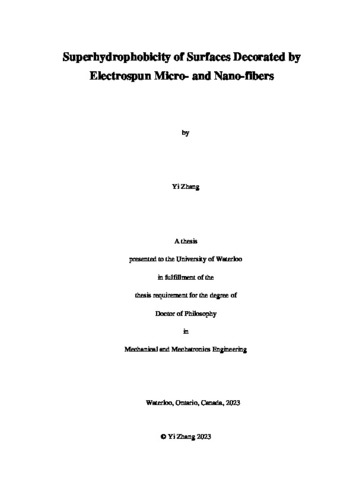UWSpace will be migrating to a new version of its software from July 29th to August 1st. UWSpace will be offline for all UW community members during this time.
Superhydrophobicity of Surfaces Decorated by Electrospun Micro- and Nano-fibers
| dc.contributor.author | Zhang, Yi | |
| dc.date.accessioned | 2023-08-17 13:00:36 (GMT) | |
| dc.date.available | 2023-08-17 13:00:36 (GMT) | |
| dc.date.issued | 2023-08-17 | |
| dc.date.submitted | 2023-08-14 | |
| dc.identifier.uri | http://hdl.handle.net/10012/19700 | |
| dc.description.abstract | Electrospinning is proven to be an efficient and versatile technique for developing super-hydrophobicity based on the surface roughness provided by the generated micro- and nano- fibers. However, current electrospinning methods suffer from a lack of strategic approach to superhydrophobicity and complex fabrication. Based on the influence of fiber morphology parameters on surface wettability, this thesis research aims to develop rose-petal and lotus superhydrophobic surfaces using uniaxially aligned fibers and biaxially aligned porous fibers, respectively. Both fibers are fabricated by simple one-step electrospinning. This thesis starts with building an integrated thermodynamic model for droplet wetting on various parallel-structured surfaces to understand the wetting behavior. The model relates free energy to the continuous movement of three-phase contact lines in different wetting states, and the forming conditions of free energy barrier are derived from the model. Then the model and the forming conditions of energy barrier are validated using data in the literature and experimental data using aligned fibers. The model indicates that compared to structures with sharp edge, round structures can broaden the range of apparent contact angle (APCA) for energy barriers. Thus, surfaces patterned by round structures can achieve large APCAs with high contact angle hysteresis, which are needed for rose-petal effect. Then this thesis specifies the wetting model for surfaces patterned by uniaxially aligned fibers based on the preceding integrated model. The model indicates that the energy barrier increases with fiber diameter and the basal width of droplet. Uniaxially aligned polystyrene fibers with average diameters of 0.9 and 1.8 μm and inter-fiber distance (l) from 70 to 1450 μm are fabricated to study the wetting behavior on surfaces dressed by aligned fibers. Based on the wetting behavior, petal-effect surfaces are fabricated using uniaxially aligned fibers with an average diameter of 1.8 μm and l between 70 and 130 μm. The APCAs of the petal-effect surfaces are in a range of 150˚-156˚, and droplets can adhere to the surfaces even by turning the surfaces upside down. After that, this thesis studies the wetting behavior on surfaces dressed by aligned porous fibers. Uniaxially and biaxially aligned porous fibers are fabricated onto substrate surfaces through one-step electrospinning with controlled relative humidity. On the uniaxially aligned fibers, droplets are in the Cassie-Baxter (CB) state when l is less than 18.2 μm. For l greater than 18.2 μm, wetting transition to the Wenzel state occurs. On the biaxially aligned porous fibers, droplets stay in CB state even when l reaches 34 μm. More importantly, there is no change in the variation trend of hydrophobicity for l between 18.2 and 34 μm compared to that for l below 18.2 μm, indicating that the droplets stay on the upper-layer fibers without contacting the lower-layer fibers or substrate. Numerical simulation using Surface Evolver shows that a Cassie-Baxter-“restoring” (CaRe) wetting contributes to a more stable CB state in the biaxial structure. Lotus-effect surfaces are thus developed based on the CaRe wetting using the biaxial structure. As a result, the developed structure has contact angles between 159˚ and 162˚ and roll-off angles from 10˚ to 3˚ for water droplets from 3 to 10 µL in volume. Finally, two potential applications of the developed biaxial structure are demonstrated. First, the biaxial structure is used to develop a waterproof, breathable, and superhydrophobic membrane by depositing fibers on a supporting commercial nylon mesh. The breathability of the membrane is quantified by water vapor transmission rate, which is 20.8± 0.1 kg·m−2·d−1. The second application is a surface layer for wearable electronics. After being patched with the biaxial structure for 60 minutes, the human forearm skin shows unnoticeable change in temperature. In addition, the average transmittance in the visible region (380-760 nm) of the biaxial structure is 83.6 ± 3.1% using a UV-Vis spectrophotometer. | en |
| dc.language.iso | en | en |
| dc.publisher | University of Waterloo | en |
| dc.title | Superhydrophobicity of Surfaces Decorated by Electrospun Micro- and Nano-fibers | en |
| dc.type | Doctoral Thesis | en |
| dc.pending | false | |
| uws-etd.degree.department | Mechanical and Mechatronics Engineering | en |
| uws-etd.degree.discipline | Mechanical Engineering | en |
| uws-etd.degree.grantor | University of Waterloo | en |
| uws-etd.degree | Doctor of Philosophy | en |
| uws-etd.embargo.terms | 0 | en |
| uws.contributor.advisor | Tan, Zhongchao | |
| uws.contributor.affiliation1 | Faculty of Engineering | en |
| uws.published.city | Waterloo | en |
| uws.published.country | Canada | en |
| uws.published.province | Ontario | en |
| uws.typeOfResource | Text | en |
| uws.peerReviewStatus | Unreviewed | en |
| uws.scholarLevel | Graduate | en |

